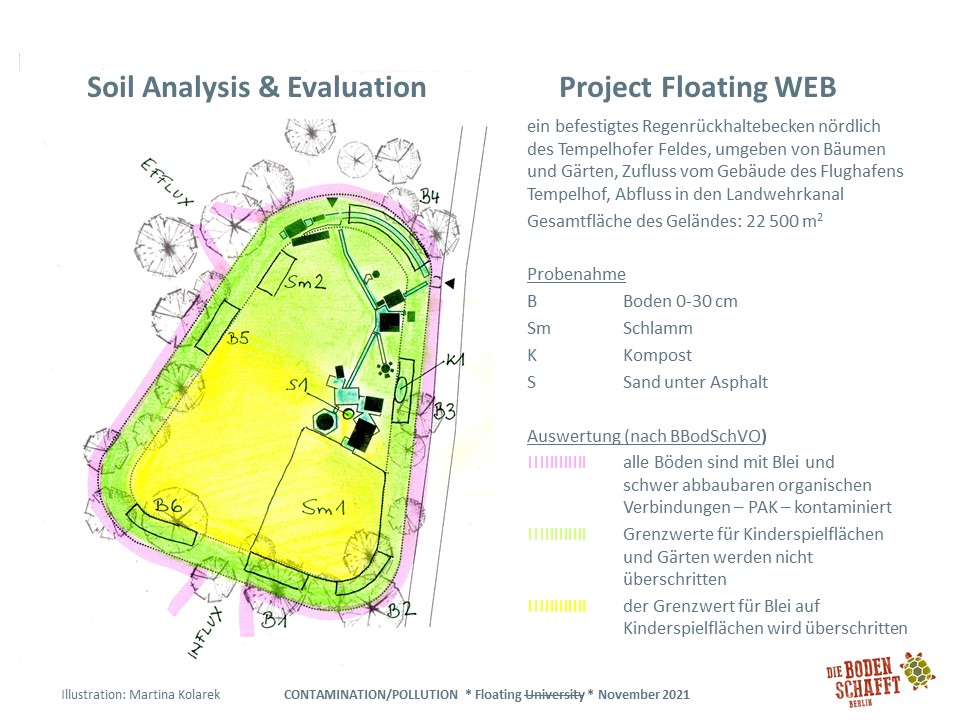Results Soil Analysis
SOIL ANALYSIS IN FLOATING UNIVERSITY 2021
Contamination or pollution?
In one of our first meetings with association members and gardeners from “Kolonie am Flughafen” we talked about difference between contamination and pollution. All the soil in cities is contaminated. When this contamination reaches a certain point where it is harming living beings, we talk about pollution. In the field of soil analysis, the term “contamination” is always negative. We just look at the bad things when we check the contamination/pollution of soil.
Contamination and pollution on Floating Site
Pink: all the grounds on Floating Area are contaminated
Green: Values of the results are below the test values for children’s play areas, so these areas are fine for being in contact with the soil
Yellow: Polluted. Main problem is lead. Results are above the test values for children’s play grounds. Don’t touch it with your skin, don’t inhale it. These samples have been collected from the mud at the entrance of the tunnel water. (Now removed on the left behind the Auditorium).
Also, some PAH, Polycyclic Aromatic Hydrocarbons, have been found: they can’t be degraded by living organisms. They are ubiquitous environmental pollutants generated primarily during the incomplete combustion of organic materials (e.g. coal, oil, petrol, and wood). For the groundwater, a regulation of these PAHs exists, but for the soil, there is still no regulation for some sorts of PAHs.
Evaluation : soil contamination and pollution on site (by BundesBodenSchutzVO)
Soil in the forest, compost and sand from under the concrete: heavy metals (lead, cadmium, nickel) and Benzo(a)pyren (carcinogene persistent organics)
➢ under the limit values for children playgrounds and gardens
Mud in the basin: heavy metals, pesticides and dangerous persistent organics (PAK,PCB/PCP)
➢ lead (228 mg/kg TS) slightly over the limit value for children playgrounds (200), cadmium (2,1 mg/kg TS) slightly over the limit value for children in gardens (2) at the inflow (outflow ok)
➢ relative high concentration of PAH (still no limit values for soils, only for water…) verification and more information necessary
Chemische Analyse chemical analysis
Interpretation of scientific results
The sludge in the rainwater retention basin was analyzed as part of the water analysis and the soil analysis. Different results were obtained depending on whether the research interest is on the substances that escape from the sludge or those that remain in the sludge. In most cases, the substances that can escape from the soil within a short period of time are studied, whether they are nutrients for horticulture or pollutants for hydraulic engineering measures. In contrast, we studied the substances that remain in the soil and can accumulate at the site.
Apart from different perspectives, system limitations must also be taken into account in chemical analyses: for example, no limit values can be set for long-term effects like toxic for reproduction or cancer-causing and the impact of most pollutants on soil organisms are unknown.
OPEN SOIL LAB
Open Soil Labs are facilities open to all, allowing participants to spatially experience the soil and get a holistic picture of the many different soil creatures and how they interact. DIE BODEN SCHAFFT built the first Open Soil Lab with the help of the Postcode Lottery for the Floating University. Using microscopes, cameras and simple analysis methods, soil activity and diversity can be measured and experienced for yourself. Interested individuals and groups can sign up for this at www.die-boden-schafft.de .
Text: Martina Kolarek is a soil scientist and artist, founder of DIE BODEN SCHAFFT and member of the Floating e.V.


